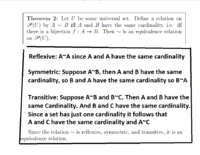Steven G
Elite Member
- Joined
- Dec 30, 2014
- Messages
- 14,603
Hi,
I did a proof that my mathematician friend said was wrong. He claims that I should show bijections. I am sure that he is correct but I do not see why my trivial proof is wrong.
The statement of the theorem along with my proof is below.
Theorem 2: Let U be some universal set. Define a relation on [math]\mathcal{P}(U)[/math] by [math]A\, \sim\, B[/math] iff [math]A[/math] and [math]B[/math] have the same cardinality; that is, iff there is a bijection [math]f\, :\, A\, \rightarrow\, B.[/math] Then [math]\sim[/math] is an equivalence relation on [math]\mathcal{P}(U).[/math]
Proof:
Reflexive: [math]A\, \sim\, A[/math] since [math]A[/math] and [math]A[/math] have the same cardinality.
Symmetric: Suppose [math]A\, \sim\, B.[/math] Then [math]A[/math] and [math]B[/math] have the same cardinality, so [math]B[/math] and [math]A[/math] have the same cardinality. Then [math]B\, \sim\, A.[/math]
Transitive: Suppose [math]A\, \sim\, B[/math] and [math]B\, \sim\, C.[/math] Then [math]A[/math] and [math]B[/math] have the same cardinality, and [math]B[/math] and [math]C[/math] have the same cardinality. Since a set has only one cardinality, it follows that [math]A[/math] and [math]C[/math] must have the same cardinality, and [math]A\, \sim\, C.[/math]
Since the relation [math]\sim[/math] is reflexive, symmetric, and transitive, it is an equivalence relation.
Thanks for your time!
I did a proof that my mathematician friend said was wrong. He claims that I should show bijections. I am sure that he is correct but I do not see why my trivial proof is wrong.
The statement of the theorem along with my proof is below.
Theorem 2: Let U be some universal set. Define a relation on [math]\mathcal{P}(U)[/math] by [math]A\, \sim\, B[/math] iff [math]A[/math] and [math]B[/math] have the same cardinality; that is, iff there is a bijection [math]f\, :\, A\, \rightarrow\, B.[/math] Then [math]\sim[/math] is an equivalence relation on [math]\mathcal{P}(U).[/math]
Proof:
Reflexive: [math]A\, \sim\, A[/math] since [math]A[/math] and [math]A[/math] have the same cardinality.
Symmetric: Suppose [math]A\, \sim\, B.[/math] Then [math]A[/math] and [math]B[/math] have the same cardinality, so [math]B[/math] and [math]A[/math] have the same cardinality. Then [math]B\, \sim\, A.[/math]
Transitive: Suppose [math]A\, \sim\, B[/math] and [math]B\, \sim\, C.[/math] Then [math]A[/math] and [math]B[/math] have the same cardinality, and [math]B[/math] and [math]C[/math] have the same cardinality. Since a set has only one cardinality, it follows that [math]A[/math] and [math]C[/math] must have the same cardinality, and [math]A\, \sim\, C.[/math]
Since the relation [math]\sim[/math] is reflexive, symmetric, and transitive, it is an equivalence relation.
Thanks for your time!
Attachments
Last edited by a moderator:

